The CH3D Absorption Spectrum Near 1.58 μm: Extended Line Lists and Rovibrational Assignments
Abstract
1. Introduction
2. Experimental Details, Line List Construction, and 2T-Method
3. Spectra Analysis
3.1. Rovibrational Assignments
3.2. Energy Levels
4. Discussion
4.1. Comparison Between Experiment and Theory
4.2. Comparison with Previous Works
5. Conclusions
Supplementary Materials
Author Contributions
Funding
Institutional Review Board Statement
Informed Consent Statement
Data Availability Statement
Acknowledgments
Conflicts of Interest
References
- de Bergh, C.; Lutz, B.L.; Owen, T.; Brault, J.; Chauville, J. Monodeuterated methane in the outer solar system. II. Its detection on Uranus at 1.6 microns. Astrophys. J. 1986, 311, 501–510. [Google Scholar] [CrossRef]
- de Bergh, C.; Lutz, B.L.; Owen, T.; Maillard, J.P. Monodeuterated methane in the outer solar system. IV. Its detection and abundance on Neptune. Astrophys. J. 1990, 355, 661–666. [Google Scholar] [CrossRef] [PubMed]
- de Bergh, C.; Lutz, B.L.; Owen, T.; Chauville, J. Monodeuterated methane in the outer solar system. III. Its abundance on Titan. Astrophys. J. 1988, 329, 951–955. [Google Scholar] [CrossRef]
- Penteado, P.F.; Griffith, C.; Greathouse, T.K.; de Bergh, C. Measurements of CH3D and CH4 in Titan from infrared spectroscopy. Astrophys. J. 2005, 629, L53–L56. [Google Scholar] [CrossRef]
- de Bergh, C.; Courtin, R.; Bézard, B.; Coustenis, C.; Lellouch, E.; Hirtzig, M.; Rannou, P.; Drossart, P.; Campargue, A.; Kassi, S.; et al. Applications of a new set of methane line parameters to the modeling of Titan’s spectrum in the 1.58-micron window. Planet. Space Sci. 2012, 61, 85–99. [Google Scholar] [CrossRef]
- Wang, L.; Kassi, S.; Liu, A.W.; Hu, S.M.; Campargue, A. High sensitivity absorption spectroscopy of methane at 80 K in the 1.58 µm transparency window: Temperature dependence and importance of the CH3D contribution. J. Mol. Spectrosc. 2010, 261, 41–52. [Google Scholar] [CrossRef]
- Lu, Y.; Mondelain, D.; Kassi, S.; Campargue, A. The CH3D absorption spectrum in the 1.58 μm transparency window of methane: Empirical line lists and temperature dependence between 80 K and 296 K. J. Quant. Spectrosc. Radiat. Transf. 2011, 112, 2683–2697. [Google Scholar] [CrossRef]
- Gordon, I.E.; Rothman, L.S.; Hargreaves, R.J.; Hashemi, R.; Karlovets, E.V.; Skinner, F.M.; Conway, E.K.; Hill, C.; Kochanov, R.V.; Tan, Y.; et al. The HITRAN2020 molecular spectroscopic database. J. Quant. Spectrosc. Radiat. Transf. 2022, 277, 107949. [Google Scholar] [CrossRef]
- Campargue, A.; Leshchishina, O.; Wang, L.; Mondelain, D.; Kassi, S. The WKLMC empirical line lists (5852–7919 cm−1) for methane between 80 K and 296 K: Final lists for atmospheric and planetary applications. J. Mol. Spectrosc. 2013, 291, 16–22. [Google Scholar] [CrossRef]
- Lutz, B.L.; de Bergh, C.; Maillard, J.P. Monodeuterated methane in the outer solar system. I. Spectroscopic analysis of the bands at 1.55 and 1.95 microns. Astrophys. J. 1983, 273, 397–409. [Google Scholar] [CrossRef]
- Boussin, C.; Lutz, B.L.; de Bergh, C.; Hamdouni, A. Line intensities and self-broadening coefficients for the 3ν2 band of monodeutrated methane. J. Quant. Spectrosc. Radiat. Transf. 1998, 60, 501–514. [Google Scholar] [CrossRef]
- Boussin, C.; Lutz, B.L.; Hamdouni, A.; de Bergh, C. Pressure broadening and shift coefficients for H2, He and N2 in the 3ν2 band of 12CH3D retrieved by a multispectrum fitting technique. J. Quant. Spectrosc. Radiat. Transf. 1999, 63, 49–84. [Google Scholar] [CrossRef]
- Ulenikov, O.N.; Bekhtereva, E.S.; Albert, S.; Bauerecker, S.; Hollenstein, H.; Quack, M. High resolution infrared spectroscopy and global vibrational analysis for the CH3D and CHD3 isotopomers of methane. Mol. Phys. 2010, 108, 1209–1240. [Google Scholar] [CrossRef]
- Kassi, S.; Gao, B.; Romanini, D.; Campargue, A. The near infrared (1.30–1.70 µm) absorption spectrum of methane down to 77 K. Phys. Chem. Chem. Phys. 2008, 10, 4410–4419. [Google Scholar] [CrossRef]
- Nikitin, A.V.; Thomas, X.; Régalia, L.; Daumont, L.; Von der Heyden, P.; Tyuterev, V.G.; Wang, L.; Kassi, S.; Campargue, A. First assignment of the 5ν4 and ν2+4ν4 band systems of 12CH4 in the 6287–6550 cm−1 region. J. Quant. Spectrosc. Radiat. Transf. 2011, 112, 28–40. [Google Scholar] [CrossRef]
- Campargue, A.; Leshchishina, O.; Mondelain, D.; Kassi, S.; Coustenis, A. An improved empirical line list for methane in the region of the 2ν3 band at 1.66 μm. J. Quant. Spectrosc. Radiat. Transf. 2013, 118, 49–59. [Google Scholar] [CrossRef]
- Nikitin, A.V.; Chizhmakova, I.S.; Rey, M.; Tashkun, S.A.; Kassi, S.; Mondelain, D.; Campargue, A.; Tyuterev, V.G. Analysis of the absorption spectrum of 12CH4 in the region 5855–6250 cm−1 of the 2ν3 band. J. Quant. Spectrosc. Radiat. Transf. 2017, 203, 341–348. [Google Scholar] [CrossRef]
- Mondelain, D.; Kassi, S.; Wang, L.; Campargue, A. The 1.28 µm transparency window of methane (6165–6750 cm−1): Empirical line list and temperature dependence between 80 K and 296 K. Phys. Chem. Chem. Phys. 2011, 17, 7985–7996. [Google Scholar] [CrossRef]
- Nikitin, A.V.; Rey, M.; Campargue, A.; Tyuterev, V.G. First assignments of the 6ν4, ν2+ 5ν4, and ν1+4ν4 Triacontad band system of 12CH4 in the 7606–7919 cm−1 region. J. Quant. Spectrosc. Radiat. Transf. 2024, 325, 109098. [Google Scholar] [CrossRef]
- Brown, L.R.; Sung, K.; Benner, D.C.; Devi, V.M.; Boudon, V.; Gabard, T.; Wenger, C.; Campargue, A.; Leshchishina, O.; Kassi, S.; et al. Methane line parameters in the HITRAN2012 database. J. Quant. Spectrosc. Radiat. Transf. 2013, 130, 201–219. [Google Scholar] [CrossRef]
- Rey, M.; Nikitin, A.V.; Tyuterev, V.G. First-principles intensity calculations for the methane rovibrational spectra in the infrared up to 9300 cm−1. Phys. Chem. Chem. Phys. 2013, 15, 10049–10061. [Google Scholar] [CrossRef] [PubMed]
- Rey, M.; Nikitin, A.V.; Tyuterev, V.G. Accurate first-principles calculations for CH3D infrared spectra from isotopic and symmetry transformations. J. Chem. Phys. 2014, 141, 044316. [Google Scholar] [CrossRef] [PubMed]
- Rey, M.; Nikitin, A.V.; Tyuterev, V.G. Convergence of normal mode variational calculations of methane spectra: Theoretical linelist in the icosad range computed from potential energy and dipole moment surfaces. J. Quant. Spectrosc. Radiat. Transf. 2015, 164, 207–220. [Google Scholar] [CrossRef]
- Ben Fathallah, O.; Rey, M.; Campargue, A. The ethylene absorption spectrum between 6075 and 8050 cm−1: Empirical line list and rovibrational assignments. J. Quant. Spectrosc. Radiat. Transf. 2024, 329, 109175. [Google Scholar] [CrossRef]
- Cacciani, P.; Čermák, P.; Votava, O.; Vander Auwera, J.; Campargue, A. The ammonia absorption spectrum revisited between 5650 and 6350 cm−1. Mol. Phys. 2023, 122, e2256893. [Google Scholar] [CrossRef]
- Rey, M.; Nikitin, A.V.; Campargue, A.; Kassi, S.; Mondelain, D.; Tyuterev, V.G. Ab initio variational predictions for understanding highly congested spectra: Rovibrational assignment of 108 new methane sub-bands in the icosad range (6280–7800 cm−1). Phys. Chem. Chem. Phys. 2016, 16, 176–189. [Google Scholar] [CrossRef]
- Rey, M.; Nikitin, A.V.; Babikov, Y.; Tyuterev, V.G. TheoReTS—An information system for theoretical spectra based on variational predictions from molecular potential energy and dipole moment surfaces. J. Mol. Spectrosc. 2016, 327, 138–158. [Google Scholar] [CrossRef]
- Nikitin, A.V.; Rey, M.; Tyuterev, V.G. Accurate line intensities of methane from first-principles calculations. J. Quant. Spectrosc. Radiat. Transf. 2017, 200, 90–99. [Google Scholar] [CrossRef]
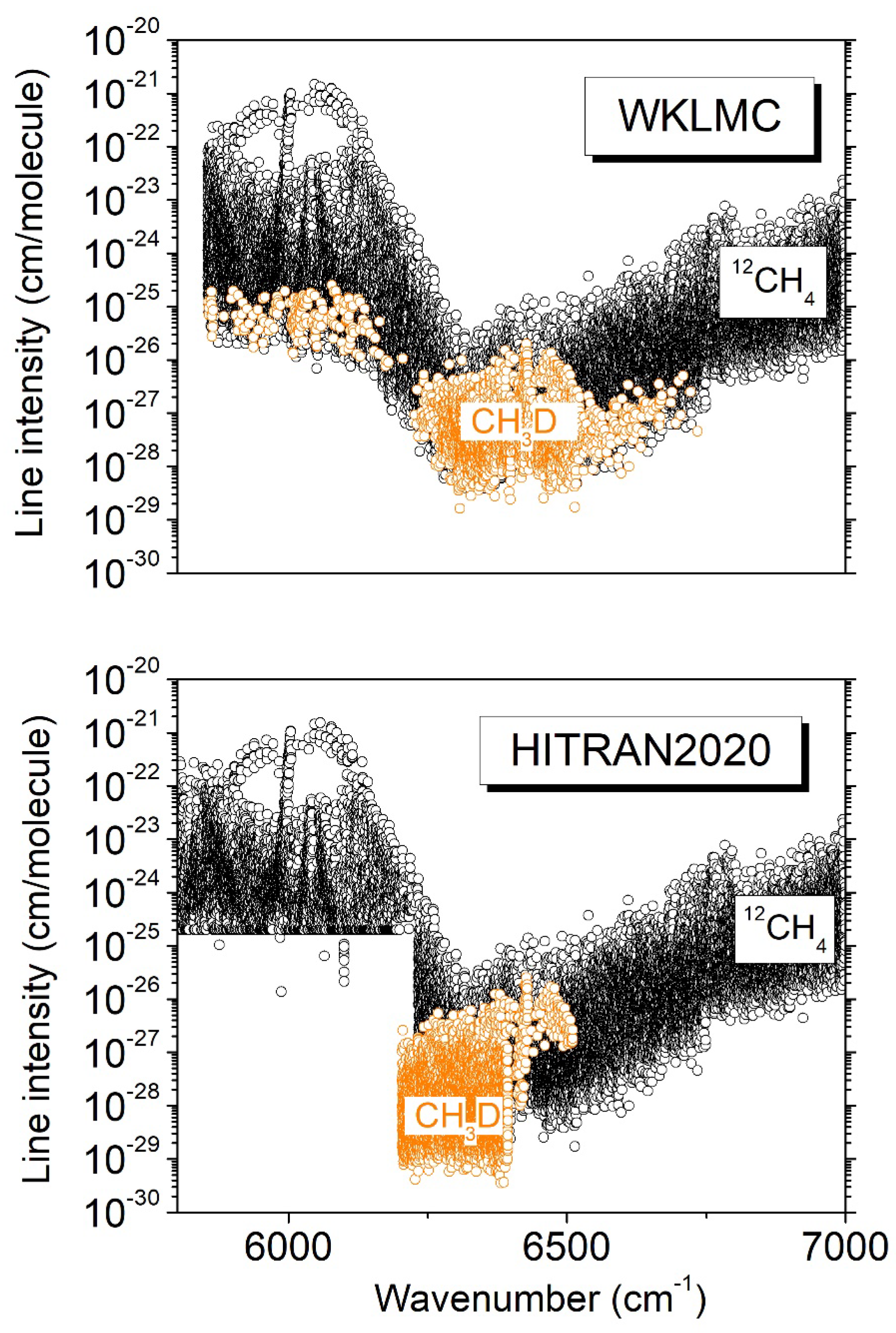

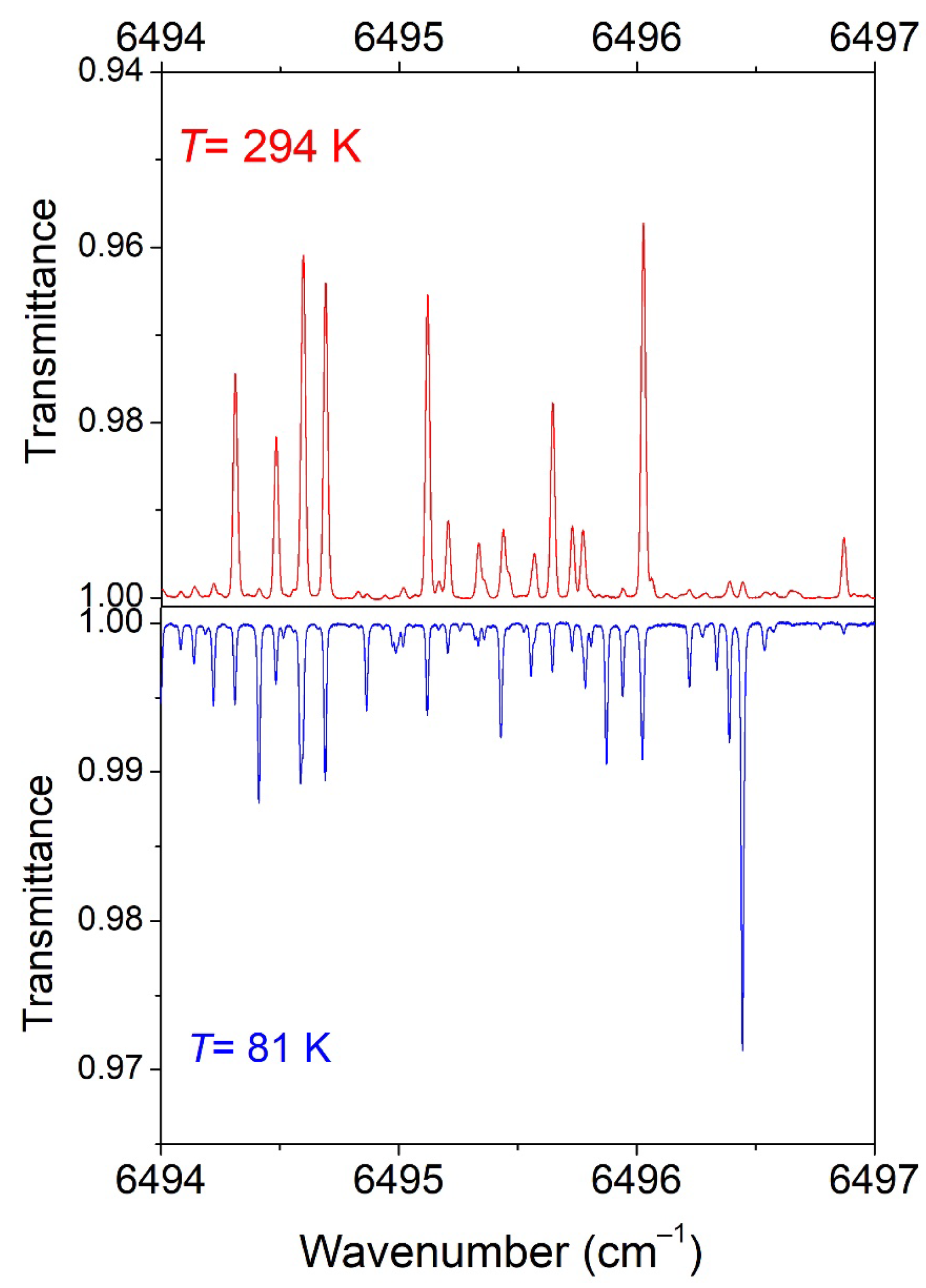
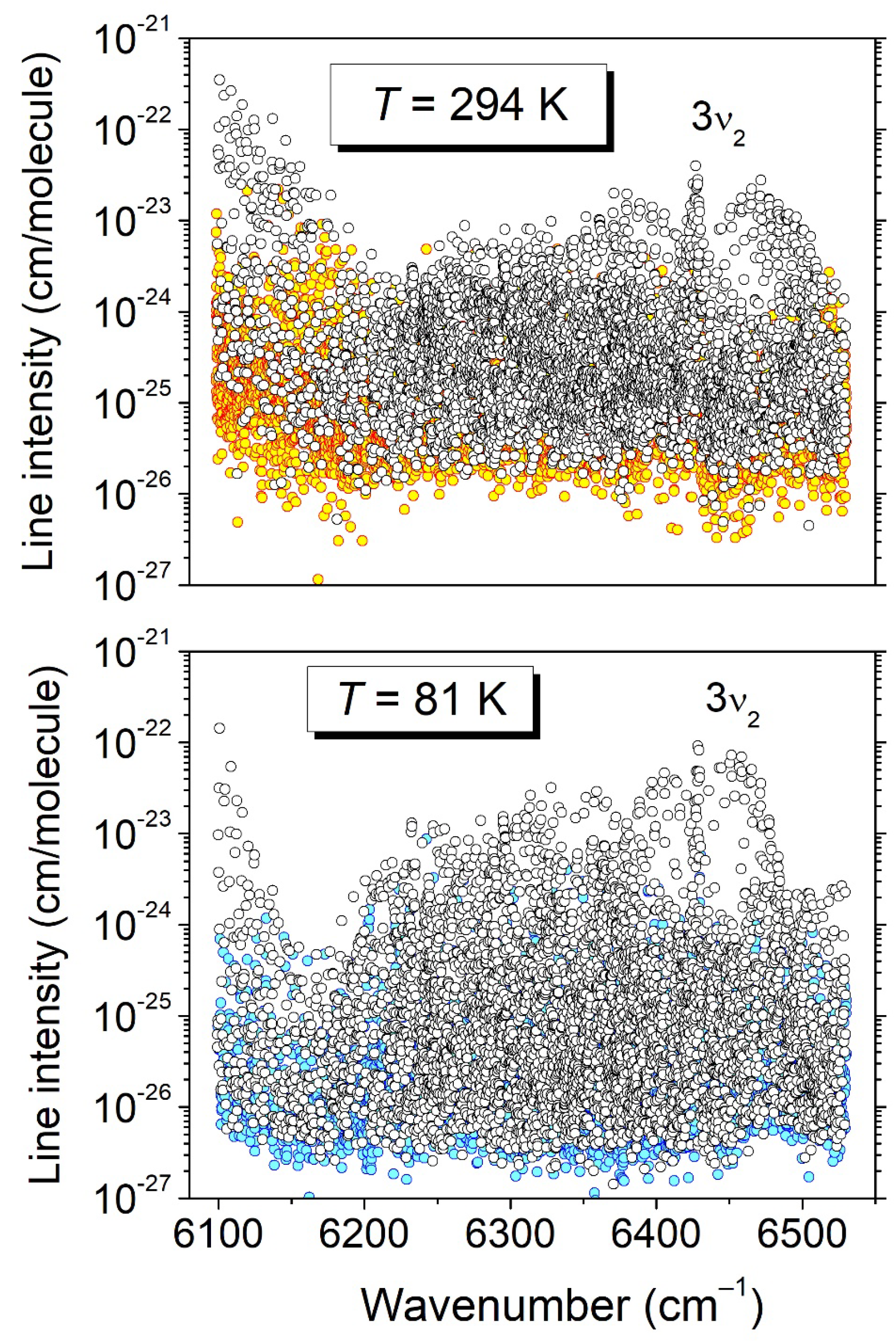
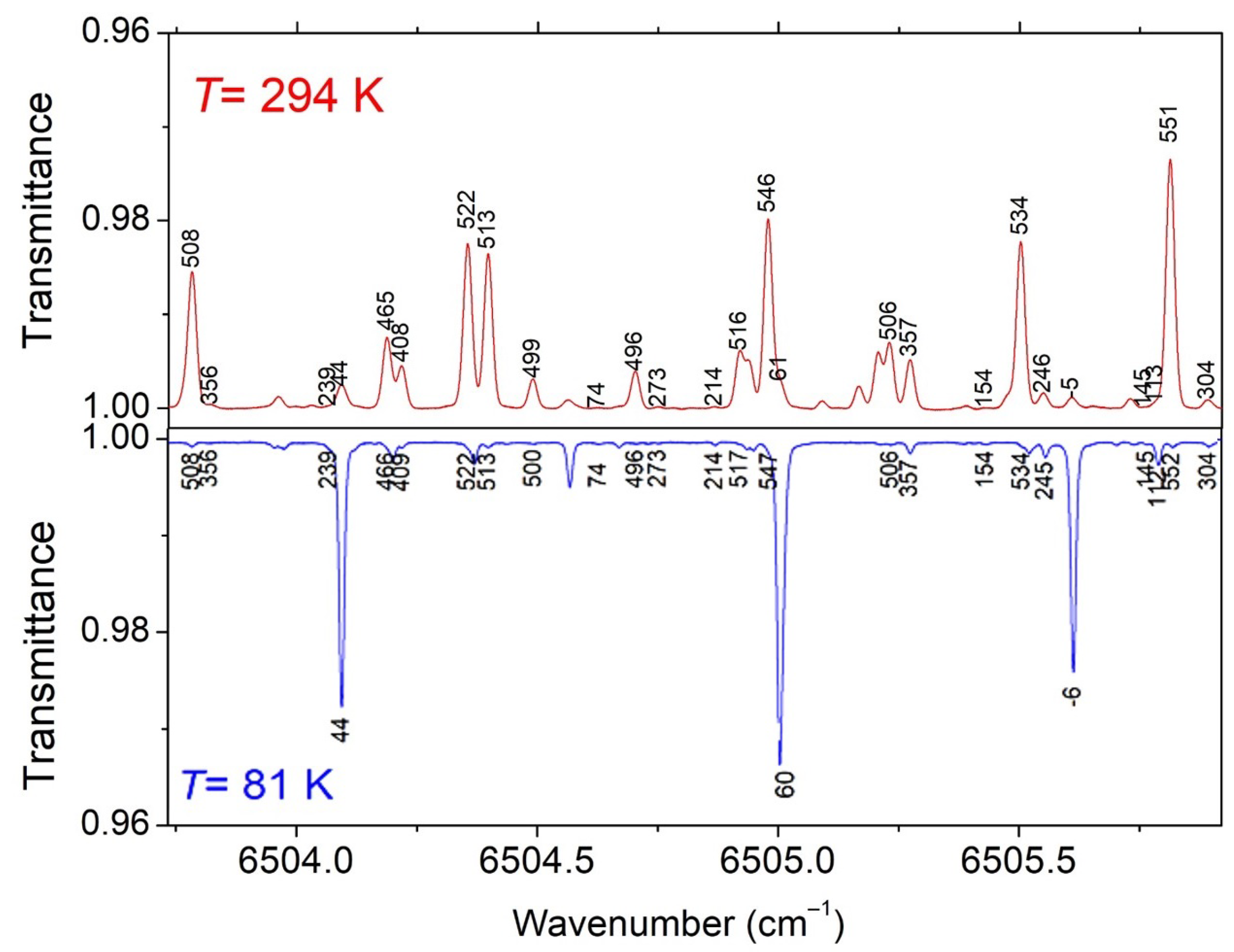

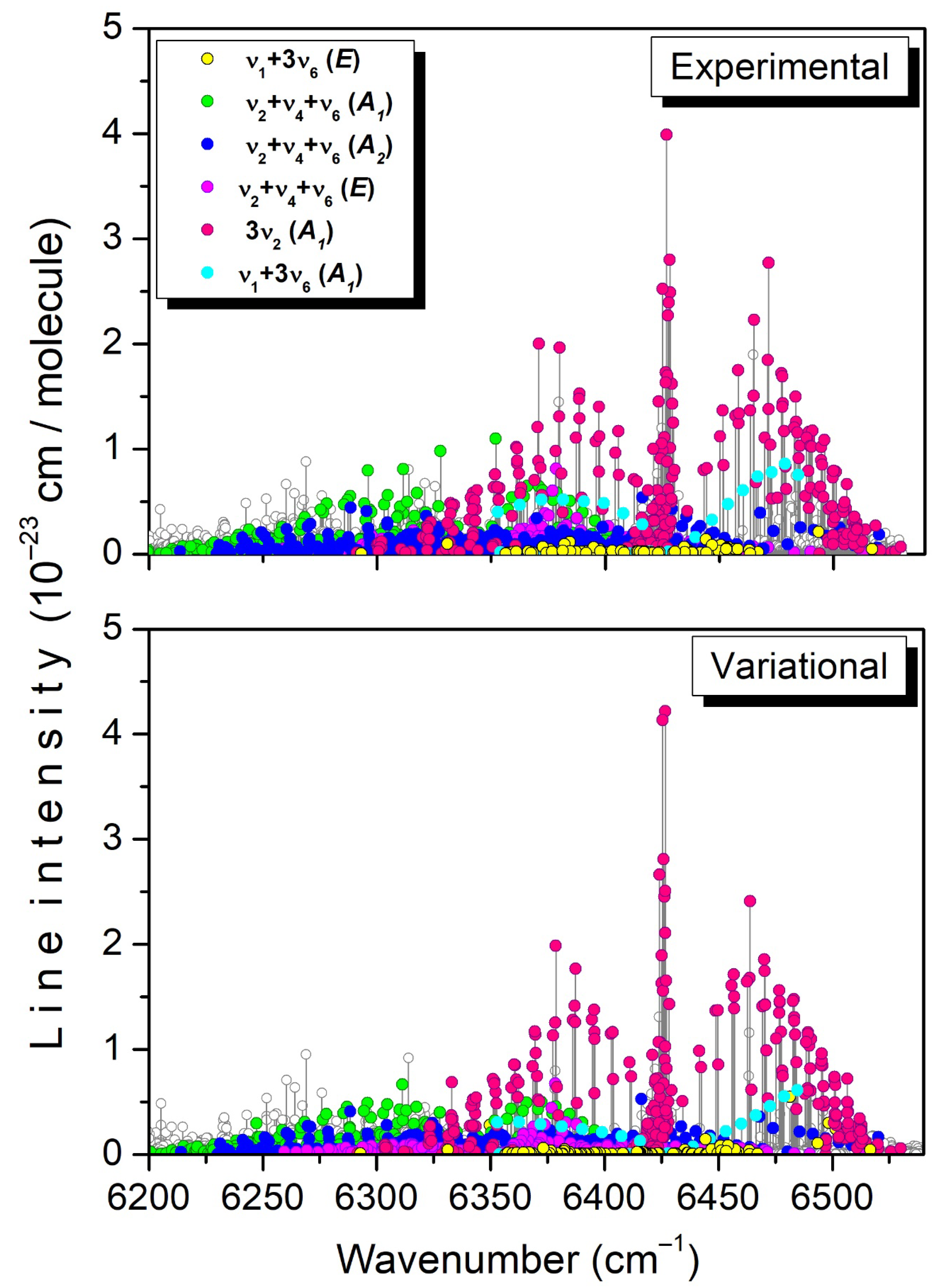


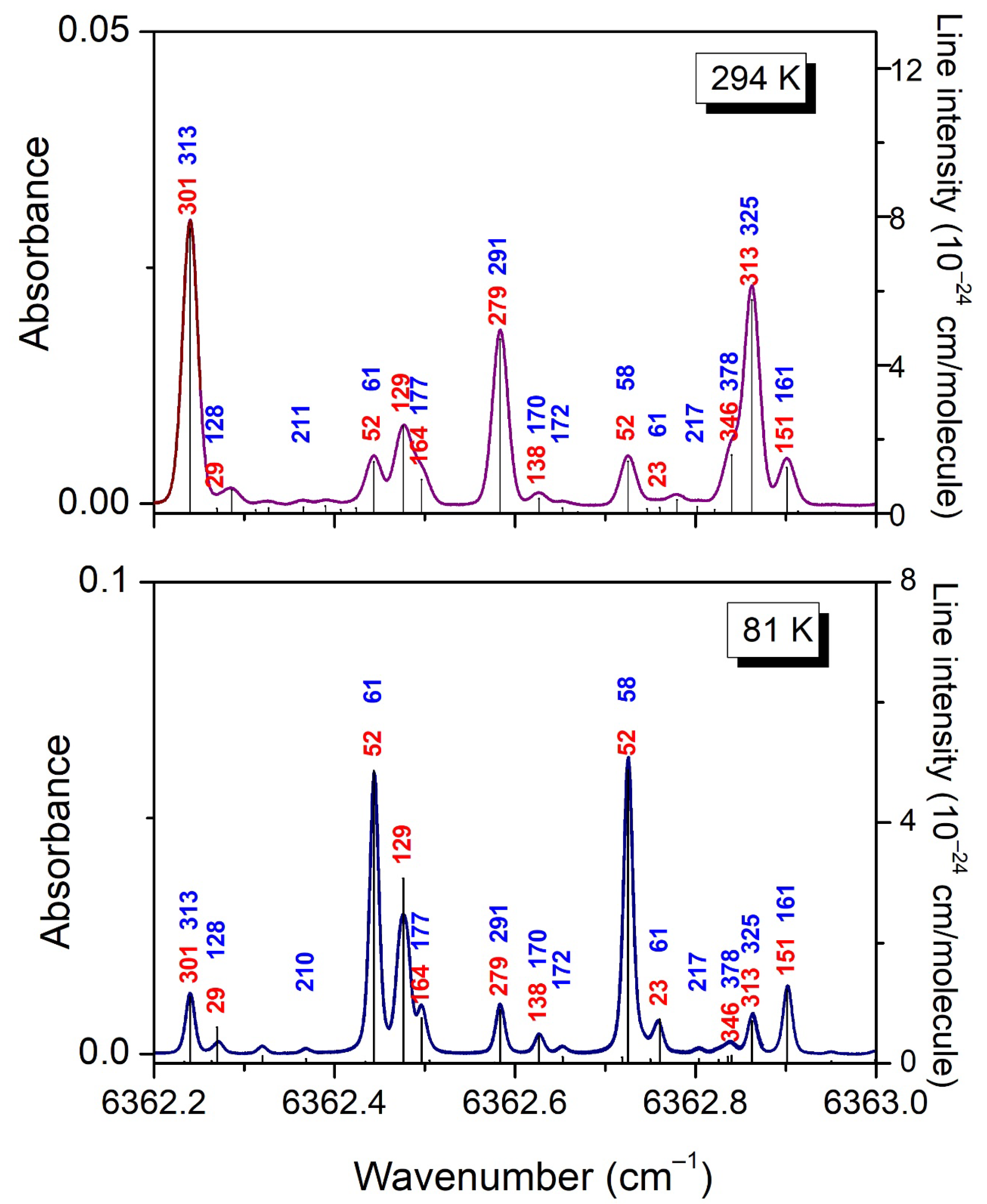


| Variational | Assigned Lines | ||||||||||
|---|---|---|---|---|---|---|---|---|---|---|---|
| Band | Sym. | Band Center (cm−1) a | Nb. b | Int. Sum 296 K c (cm/Molecule) | Number | Jmax | Kmax | Int. Sum (cm/Molecule) | |||
| RV d | Eemp e | ||||||||||
| Exp. | Var. | Exp./Var. | |||||||||
| ν2 + 2ν5 + ν6 | E | 6236.3581 (0.54) 6277.7417 (0.79) | 1298 | 5.82 × 10−22 | 532 | 439 | 11 | 9 | 5.11 × 10−22 | 5.53 × 10−22 | 0.92 |
| ν2 + 2ν5 + ν6 | A1 | 6254.1267 (0.84) | 348 | 3.06 × 10−23 | 135 | 71 | 9 | 8 | 2.19 × 10−23 | 2.27 × 10−23 | 0.96 |
| ν1 + ν2 + ν6 | E | 6298.5429 (0.61) | 388 | 4.58 × 10−22 | 189 | 173 | 11 | 10 | 4.06 × 10−22 | 4.49 × 10−22 | 0.90 |
| ν2 + ν4 + ν6 | A1 | 6336.9540 (−0.76) | 433 | 4.83 × 10−22 | 246 | 216 | 11 | 10 | 5.59 × 10−22 | 4.69 × 10−22 | 1.19 |
| ν2 + ν4 + ν6 | A2 | 6356.4186 (0.67) | 321 | 1.03 × 10−22 | 146 | 128 | 11 | 9 | 1.19 × 10−22 | 9.61 × 10−23 | 1.24 |
| ν2 + ν4 + ν6 | E | 6347.7418 (0.75) | 758 | 4.21 × 10−22 | 386 | 310 | 11 | 9 | 4.18 × 10−22 | 3.96 × 10−22 | 1.06 |
| 3ν2 | A1 | 6426.9446 (0.53) | 289 | 2.07 × 10−21 | 212 | 212 | 12 | 11 | 1.95 × 10−21 | 2.05 × 10−21 | 0.95 |
| ν1 + 3ν6 | A1 | 6431.4574 (−0.62) | 136 | 1.00 × 10−22 | 61 | 30 | 9 | 5 | 1.89 × 10−22 | 9.35 × 10−23 | 2.02 |
| ν1 + 3ν6 | E | 6417.2823 (0.59) | 268 | 2.84 × 10−23 | 110 | 73 | 9 | 9 | 2.65 × 10−23 | 2.48 × 10−23 | 1.07 |
| 2ν5 + 3ν6 | A1 | 6376.2454 (0.50) 6374.0419 (−0.69) | 226 | 1.54 × 10−23 | 20 | 15 | 12 | 5 | 1.02 × 10−23 | 9.70 × 10−24 | 1.05 |
| 2ν5 + 3ν6 | A2 | 6378.2876 (0.71) 6375.1935 (−0.52) | 364 | 2.30 × 10−23 | 38 | 21 | 8 | 6 | 2.30 × 10−23 | 1.57 × 10−23 | 1.46 |
| 2ν5 + 3ν6 | E | 6431.1383 (−0.63) | 1351 | 7.05 × 10−23 | 50 | 33 | 11 | 7 | 2.80 × 10−23 | 3.01 × 10−23 | 0.93 |
| 6396.3973 (0.82) | |||||||||||
| 6368.9869 (−0.62) | |||||||||||
| ν4 + 3ν6 | A1 | 6460.5624 (0.74) | 269 | 1.35 × 10−23 | 24 | 24 | 11 | 10 | 4.63 × 10−24 | 4.12 × 10−24 | 1.12 |
| ν4 + 3ν6 | A2 | 6478.6942 (−0.83) | 212 | 6.43 × 10−24 | 4 | 4 | 9 | 7 | 1.10 × 10−24 | 1.10 × 10−24 | 1.00 |
| ν4 + 3ν6 | E | 6464.6815 (0.66) | 1092 | 1.33 × 10−22 | 199 | 162 | 12 | 5 | 7.55 × 10−23 | 7.49 × 10−23 | 1.01 |
| 6480.2012 (0.74) | |||||||||||
| 6482.9860 (0.67) | |||||||||||
| ν3 + ν5 + 3ν6 | E | 6255.4872 (0.60) | 1009 | 9.81 × 10−23 | 177 | 105 | 10 | 6 | 6.13 × 10−23 | 6.72 × 10−23 | 0.91 |
| 6219.9269 (−0.83) | |||||||||||
| 6224.6451 (−0.59) | |||||||||||
| 2ν3 + ν5 + 2ν6 | A2 | 6353.4585 (−0.62) | 252 | 3.30 × 10−23 | 43 | 33 | 7 | 5 | 2.70 × 10−23 | 1.85 × 10−23 | 1.46 |
| ν2 + ν3 + 2ν5 | E | 6427.0159 (−0.87) | 404 | 8.62 × 10−23 | 28 | 22 | 11 | 3 | 7.82 × 10−23 | 4.75 × 10−23 | 1.65 |
| ν2 + ν3 + ν4 | E | 6505.0296 (−0.81) | 378 | 8.89 × 10−23 | 108 | 82 | 9 | 7 | 4.74 × 10−23 | 4.71 × 10−23 | 1.01 |
| ν2 + 2ν3 + ν5 | E | 6247.0639 (0.75) | 686 | 8.84 × 10−23 | 216 | 154 | 11 | 7 | 6.44 × 10−23 | 7.02 × 10−23 | 0.92 |
| Total | 10,482 | 4.93 × 10−21 | 2924 | 2307 | 4.62 × 10−21 | 4.54 × 10−21 | 1.02 | ||||
| Variational | Assigned Lines | ||||||||||
|---|---|---|---|---|---|---|---|---|---|---|---|
| Band | Sym. | Center (cm−1) a | Nb. b | Int. Sum 296 K c (cm/Molecule) | Number | Jmax | Kmax | Int. Sum (cm/Molecule) 294 K | |||
| RV d | Eemp e | Exp. | Var. | Exp./Var. | |||||||
| ν2 + 2ν5 + ν6 | E | 6236.3581 (0.54) | 2315 | 5.64 × 10−22 | 537 | 449 | 16 | 11 | 4.22 × 10−22 | 4.19 × 10−22 | 1.01 |
| 6277.7417 (0.79) | |||||||||||
| ν2 + 2ν5 + ν6 | A1 | 6254.1267 (0.84) | 523 | 4.21 × 10−23 | 80 | 72 | 10 | 8 | 2.51 × 10−23 | 1.91 × 10−23 | 1.31 |
| ν1 + ν2 + ν6 | E | 6298.5429 (0.61) | 915 | 3.71 × 10−22 | 231 | 183 | 14 | 12 | 2.89 × 10−22 | 2.87 × 10−22 | 1.01 |
| v2 + ν4 + ν6 | A1 | 6336.9540 (−0.76) | 818 | 3.71 × 10−22 | 301 | 229 | 14 | 12 | 4.25 × 10−22 | 3.30 × 10−22 | 1.29 |
| ν2 + ν4 + ν6 | A2 | 6356.4186 (0.67) | 700 | 1.68 × 10−22 | 163 | 137 | 12 | 10 | 1.63 × 10−22 | 1.20 × 10−22 | 1.36 |
| ν2 + ν4 + ν6 | E | 6347.7418 (0.75) | 1382 | 3.83 × 10−22 | 375 | 313 | 12 | 10 | 3.25 × 10−22 | 2.81 × 10−22 | 1.16 |
| 3ν2 | A1 | 6426.9446 (0.53) | 508 | 1.76 × 10−21 | 282 | 221 | 14 | 12 | 1.65 × 10−21 | 1.69 × 10−21 | 0.98 |
| ν1 + 3ν6 | A1 | 6431.4574 (−0.62) | 167 | 5.34 × 10−23 | 30 | 30 | 9 | 5 | 8.46 × 10−23 | 4.79 × 10−23 | 1.77 |
| ν1 + 3ν6 | E | 6417.2823 (0.59) | 490 | 4.21 × 10−23 | 87 | 75 | 15 | 9 | 2.62 × 10−23 | 1.78 × 10−23 | 1.47 |
| 2ν5 + 3ν6 | A1 | 6376.2454 (0.50) 6374.0419 (−0.69) | 237 | 2.95 × 10−23 | 21 | 13 | 15 | 6 | 2.14 × 10−23 | 1.85 × 10−23 | 1.16 |
| 2ν5 + 3ν6 | A2 | 6378.2876 (0.71) 6375.1935 (−0.52) | 340 | 2.33 × 10−23 | 22 | 20 | 10 | 6 | 7.01 × 10−24 | 4.92 × 10−24 | 1.42 |
| 2ν5 + 3ν6 | E | 6431.1383 (−0.63) | 1337 | 7.83 × 10−23 | 35 | 31 | 11 | 7 | 1.11 × 10−23 | 1.13 × 10−23 | 0.98 |
| 6396.3973 (0.82) | |||||||||||
| 6368.9869 (−0.62) | |||||||||||
| ν4 + 3ν6 | A1 | 6460.5624 (0.74) | 452 | 1.12 × 10−22 | 51 | 29 | 13 | 11 | 8.13 × 10−23 | 7.81 × 10−23 | 1.03 |
| ν4 + 3ν6 | A2 | 6478.6942 (−0.83) | 265 | 1.87 × 10−23 | 5 | 4 | 9 | 7 | 9.85 × 10−24 | 1.00 × 10−23 | 0.99 |
| ν4 + 3ν6 | E | 6464.6815 (0.66) | 1495 | 1.46 × 10−22 | 216 | 171 | 14 | 6 | 7.53 × 10−23 | 6.32 × 10−23 | 1.19 |
| 6480.2012 (0.74) | |||||||||||
| 6482.9860 (0.67) | |||||||||||
| ν3 + ν5 + 3ν6 | E | 6255.4872 (0.60) | 911 | 8.33 × 10−23 | 107 | 103 | 10 | 6 | 3.52 × 10−23 | 2.80 × 10−23 | 1.26 |
| 6219.9269 (−0.83) | |||||||||||
| 6224.6451 (−0.59) | |||||||||||
| 2ν3 + ν5 + 2ν6 | A2 | 6353.4585 (−0.62) | 258 | 2.32 × 10−23 | 36 | 33 | 7 | 5 | 1.67 × 10−23 | 1.07 × 10−23 | 1.56 |
| ν2 + ν3 + 2ν5 | E | 6427.0159 (−0.87) | 541 | 7.16 × 10−23 | 20 | 19 | 13 | 9 | 3.99 × 10−23 | 2.63 × 10−23 | 1.52 |
| ν2 + ν3 + ν4 | E | 6505.0296 (−0.81) | 573 | 6.11 × 10−23 | 106 | 87 | 11 | 7 | 2.84 × 10−23 | 2.57 × 10−23 | 1.11 |
| ν2 + 2ν3 + ν5 | E | 6247.0639 (0.75) | 1116 | 1.23 × 10−22 | 184 | 153 | 12 | 8 | 6.89 × 10−23 | 6.22 × 10−23 | 1.11 |
| Total | 15,345 | 4.53 × 10−21 | 2889 | 2372 | 3.80 × 10−21 | 3.55 × 10−21 | 1.07 | ||||
| 294 K | 81 K | |||||
|---|---|---|---|---|---|---|
| Nb. | Int. Sum (cm/Molecule) | Proportion (%) | Nb. | Int. Sum (cm/Molecule) | Proportion (%) | |
| All | 9344 | 4.90 × 10−21 | 100 | 8135 | 5.12 × 10−21 | 100 |
| Eemp | 4395 | 4.12 × 10−21 | 84.08 | 4395 | 4.84 × 10−21 | 94.53 |
| RV assign. a | 2779 | 3.77 × 10−21 | 76.94 | 2809 | 4.61 × 10−21 | 90.04 |
| RV assign. + Eemp | 2292 | 3.56 × 10−21 | 72.65 | 2230 | 4.48 × 10−21 | 87.50 |
| Only Eemp | 2099 | 5.60 × 10−22 | 11.43 | 2164 | 3.58 × 10−22 | 6.99 |
| Only RV assign. | 487 | 2.12 × 10−22 | 4.33 | 581 | 1.35 × 10−22 | 2.64 |
| Nothing | 4466 | 5.74 × 10−22 | 11.71 | 3160 | 1.49 × 10−22 | 2.91 |
Disclaimer/Publisher’s Note: The statements, opinions and data contained in all publications are solely those of the individual author(s) and contributor(s) and not of MDPI and/or the editor(s). MDPI and/or the editor(s) disclaim responsibility for any injury to people or property resulting from any ideas, methods, instructions or products referred to in the content. |
© 2024 by the authors. Licensee MDPI, Basel, Switzerland. This article is an open access article distributed under the terms and conditions of the Creative Commons Attribution (CC BY) license (https://creativecommons.org/licenses/by/4.0/).
Share and Cite
Ben Fathallah, O.; Lembei, A.; Rey, M.; Mondelain, D.; Campargue, A. The CH3D Absorption Spectrum Near 1.58 μm: Extended Line Lists and Rovibrational Assignments. Molecules 2024, 29, 5276. https://doi.org/10.3390/molecules29225276
Ben Fathallah O, Lembei A, Rey M, Mondelain D, Campargue A. The CH3D Absorption Spectrum Near 1.58 μm: Extended Line Lists and Rovibrational Assignments. Molecules. 2024; 29(22):5276. https://doi.org/10.3390/molecules29225276
Chicago/Turabian StyleBen Fathallah, Ons, Anastasiya Lembei, Michael Rey, Didier Mondelain, and Alain Campargue. 2024. "The CH3D Absorption Spectrum Near 1.58 μm: Extended Line Lists and Rovibrational Assignments" Molecules 29, no. 22: 5276. https://doi.org/10.3390/molecules29225276
APA StyleBen Fathallah, O., Lembei, A., Rey, M., Mondelain, D., & Campargue, A. (2024). The CH3D Absorption Spectrum Near 1.58 μm: Extended Line Lists and Rovibrational Assignments. Molecules, 29(22), 5276. https://doi.org/10.3390/molecules29225276







